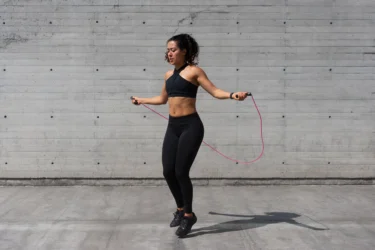Skipping rope is one of the simplest exercises that can do a lot for your fitness. It is fun, affordable, and works as both a workout and a stress reliever. All you need is a rope and a comfortable pair of shoes to begin. Skipping is an excellent cardio activity that tones the calves, strengthens the core, builds stamina, and improves lung capacity.
While skipping offers many benefits, it is not a standalone solution for weight loss. When combined with a balanced diet and regular exercise, it can help boost metabolism and support overall well-being. If you have any medical conditions or joint concerns, make sure to check with your doctor before starting.
Surprisingly, skipping ropes can significantly burn calories and also strengthen your legs, butt, shoulders, belly, and arms. On average, you can burn 200 calories in a 10-minute session each day. It is said to be more effective than brisk walking.
Did You Know?

Skipping rope is a good cardio exercise as it increases the heart rate. Regular exercise is known to support heart health2. People with pre-existing heart disease who have been advised to avoid strenuous activities should speak to their doctor before they plan to start any new form of exercise like skipping

Every cardio exercise will help you to focus better, and skipping is one of them. Skipping rope regularly can calm your mind and improve your attention span and concentration.

Skipping consistently improves your coordination and balance1. Skipping involves coordination of hand-eye-leg movements. Exercises like these are helpful for everyone. Can be started by children and adolescents at an early age to redice the risk of falls later in life.

By continuous work, you may feel tired or loss of stamina. Skipping can help you to improve blood circulation and stamina. The more you do skipping regularly the more your stamina increases. A consistent skipping range practice can help get rid of fatigue.

Skipping rope makes your body calm and flexible. Jumping gives great strength to the muscles and relaxes them. That’s why it is included in an athlete’s workout regime.

Skipping rope at a moderate intensity can reduce anxiety and depression4. Exercise can increase blood circulation to your body and brain. Exercises like skipping also help release happy hormones in brain that help improve the mood.

Belly fat is one of the main obstacles in the weight loss journey. But skipping rope, when coupled with other High-intensity interval training (HIIT) exercises, can help target belly fat5. With a healthy diet plan and the right exercises, you can strengthen your abdominal muscles.

Skipping rope, when done correctly and consistently, may help strengthen your bones and muscles, thus reducing the chances of osteoporosis3.

Post-workout glow is one of the best glow one can get. Exercises like skipping support healthy, blushing, and glowing skin.

Skipping ropes improve blood circulation and breathing which can ultimately enhance your lung capacity6. People with chronic lung problems, advised to avoid exertion should not try this exercise without speaking with their doctor.
Including skipping rope exercises into your routine may have a positive impact on your emotional well-being. It has been observed that engaging in this activity can help relax emotions, which is particularly beneficial for athletes. By promoting mental health and reducing stress, skipping rope can enhance your overall well-being7.
Dr. Siddharth Gupta, B.A.M.S, M.D (Ayu)
There are numerous ways to lose weight, and skipping rope is one of the most effective methods for it. However, skipping rope alone is not enough to lose weight also it requires a planned diet, weight loss goals, commitment, and a high activity level. You also need to consider some other factors like age, and previous illnesses/ surgeries before starting exercise as it may affect your rate of weight loss.
If you jump rope for 30 minutes to one hour daily you will lose almost 200-300 calories. But beginners can’t do it straight for 30 minutes, you may need some time to increase your duration.
Incorporating jump-roping into your fitness routine offers several advantages. Firstly, it is a low-cost physical activity that doesn’t require expensive equipment. The portable nature of a jump rope allows you to engage in this exercise virtually anywhere, even in limited spaces. Additionally, compared to other sports or fitness activities, jump-roping is an incredibly affordable option, making it accessible to individuals on various budgets8.
Dr. Rajeev Singh, BAMS
Skipping rope activates all the muscles of your body. The more you work out, the more calories you burn. As a beginner, you can start with low-intensity skipping. With practice, your control and coordination will gradually improve, and then you can enhance your intensity as you want.
The following points should be kept in mind for weight loss while skipping
Exercising is beneficial for your physical and mental health and skipping rope for weight loss is driven by proven results. But with every exercise routine, there comes the possibility of sustaining injuries. However, when done correctly, you can prevent injuries and maximise the benefits of skipping rope. Let’s take a quick look at some of these pro tips from fitness enthusiasts:
While exercising, when you are completely focused on completing your last rep no matter what, it can be hard to identify an injury-associated pain.
Muscle soreness is characterized by tiredness and tightness that can be improved over time with stretching. However, when you have an injury, it is recognizable by shooting pain, redness, swelling, and fatigue that will not go away.
When skipping rope try to avoid hard surfaces such as asphalt and concrete that leave little space for shock absorption, thus increasing the chances of an injury. Try to aim for surfaces such as lawn or rubber flooring. If there is no alternative for you and you have to skip on a hard surface make the intensity of your workout low.
Wearing the right shoes is very important to prevent injury. You must invest in good quality shoes that act as effective shock absorbers, are comfortable to wear, and make you feel good about yourself when wearing them.
How often one skips is very important for preventing an avoidable injury. Beginners are prone to sustaining injuries because enthusiasm to get to your goals faster often leads to your body getting too stressed. This leads to injuries. Rest and recovery are very important when it comes to exercising. Keep shuffling your workout routine varying between intensities and duration to keep up the interest and prevent yourself from getting injured.
No matter how rushed you are, never skip your warm-up before you start skipping. A warm-up helps to elevate your blood flow and heart rate gradually, preparing you for the real workout that is about to come!
People often underestimate the value of a good stretching routine and completely skip it off their workout routine. Stretching is key to tackling muscle tightness. On your off days and active rest days, do a solid 30-60 stretching session. You should also end your workouts with a few yoga asanas that work well as effective stretches.
Keep the rope at a lower angle. Make the landing as soft and smooth as possible
Also Read: Top 11 Habits For a Healthy Lifestyle
Skipping rope can be a fun exercise which is best to begin at a younger age. Skipping rope can be performed by adults as well, given their physical fitness and heart health allow this exercise. Do not forget to take care of your nutrition, hydration and sleep schedule to reap the most out of this healthy exercise routine.
Yes, skipping helps strengthen the core of your body. It helps to reduce belly fat and tighten the abdominals.
Depending on your fitness, health of bones and joints your doctor can guide you best on the duration of skipping everyday. To begin with, you should try to skip for at least one minute each day to feel the benefits. Increase this as you start to feel less out of breath each day.
If your goal is more caloric expenditure, then jumping rope is a better option than running. One minute of it can burn 10-16 calories, which means skipping rope for 30 minutes, segmenting into three 10-minute rounds can burn around 480 calories.
If you are a beginner at a physical activity or working out, you can slowly start your journey by skipping five minutes a day. Do this for a minimum of 2 to 3 days before increasing the time to 10 minutes then 15, 20, and more. Do not forget to get a health checkup done from a doctor before beginning a new exercise routine.
1. Trecroci A, Cavaggioni L, Caccia R, Alberti G. Jump Rope Training: Balance and Motor Coordination in Preadolescent Soccer Players. J Sports Sci Med. 2015 Nov 24;14(4):792-8. PMID: 26664276; PMCID: PMC4657422. Available from: https://pmc.ncbi.nlm.nih.gov/articles/PMC4657422/
2. Lin YY, Su CT, Liao YH, Liu YC. Effects of rope skipping exercise on physical, cardiovascular fitness and exercise tolerance in adolescent students with moderate intellectual disability. J Intellect Disabil Res. 2023 Nov;67(11):1136-1149. doi: 10.1111/jir.13071. Epub 2023 Aug 14. PMID: 37578101. Available from: https://pubmed.ncbi.nlm.nih.gov/37578101/
3. Bellver M, Drobnic F, Jovell E, Ferrer-Roca V, Abalos X, Del Rio L, Trilla A. Jumping rope and whole-body vibration program effects on bone values in Olympic artistic swimmers. J Bone Miner Metab. 2021 Sep;39(5):858-867. doi: 10.1007/s00774-021-01224-3. Epub 2021 Apr 11. PMID: 33839950. Available from: https://pubmed.ncbi.nlm.nih.gov/33839950/
4. Yamashita M, Yamamoto T. Impact of Long-Rope Jumping on Monoamine and Attention in Young Adults. Brain Sci. 2021 Oct 13;11(10):1347. doi: 10.3390/brainsci11101347. PMID: 34679411; PMCID: PMC8534060. Available from: https://pmc.ncbi.nlm.nih.gov/articles/PMC8534060/
5. Maillard F, Pereira B, Boisseau N. Effect of High-Intensity Interval Training on Total, Abdominal and Visceral Fat Mass: A Meta-Analysis. Sports Med. 2018 Feb;48(2):269-288. doi: 10.1007/s40279-017-0807-y. PMID: 29127602. Available from: https://pubmed.ncbi.nlm.nih.gov/29127602/
6. Seo K. The effects of dance music jump rope exercise on pulmonary function and body mass index after music jump rope exercise in overweight adults in 20’s. J Phys Ther Sci. 2017 Aug;29(8):1348-1351. doi: 10.1589/jpts.29.1348. Epub 2017 Aug 10. PMID: 28878460; PMCID: PMC5574342. Available from: https://pmc.ncbi.nlm.nih.gov/articles/PMC5574342/
7. Li M, Wang J. Long‑term effects of jump rope training on athletes’ physical health. Rev Bras Med Esporte. Available from: https://www.scielo.br/j/rbme/a/7S7Lb5fLtTYsgxwDt8gff7k/
8. Sohrabi Jahromi M, Gholami M. The effect of jump‑rope training on the physical fitness of 9 to 10 years old female students. Prime Scholars Publishing. Jahrom; Tehran: Islamic Azad University; 2015. Available from: https://www.primescholars.com/articles/the-effect-of-jumprope-training-on-the-physical-fitness-of-9-to-10years-old-female-students.pdf
Disclaimer: The information provided here is for educational/awareness purposes only and is not intended to be a substitute for medical treatment by a healthcare professional and should not be relied upon to diagnose or treat any medical condition. The reader should consult a registered medical practitioner to determine the appropriateness of the information and before consuming any medication. PharmEasy does not provide any guarantee or warranty (express or implied) regarding the accuracy, adequacy, completeness, legality, reliability, or usefulness of the information; and disclaims any liability arising thereof.
Links and product recommendations in the information provided here are advertisements of third-party products available on the website. PharmEasy does not make any representation on the accuracy or suitability of such products/services. Advertisements do not influence the editorial decisions or content. The information in this blog is subject to change without notice. The authors and administrators reserve the right to modify, add, or remove content without notification. It is your responsibility to review this disclaimer regularly for any changes.